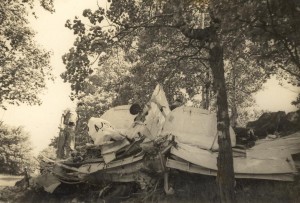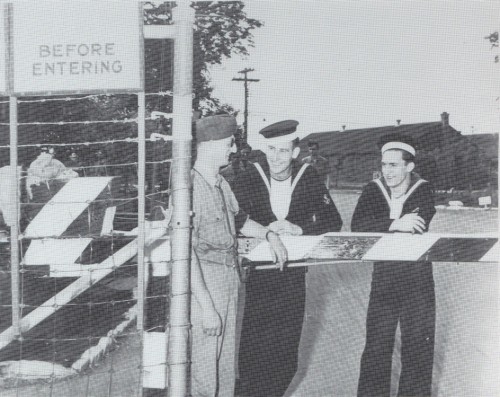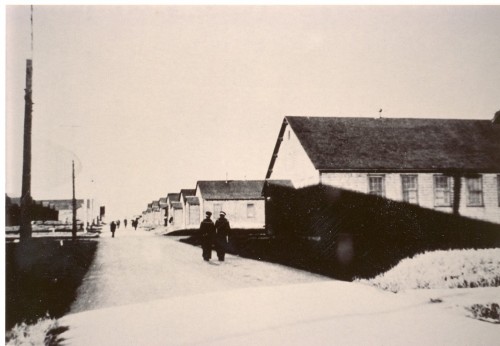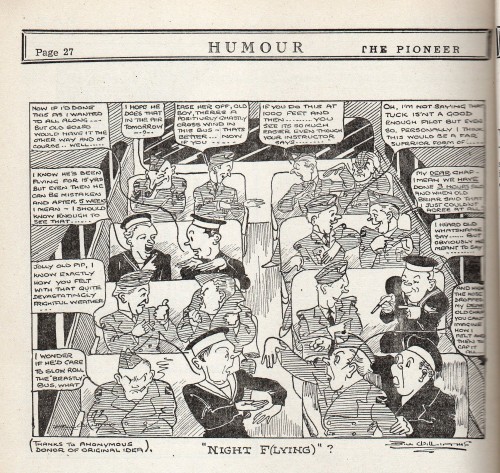A/LA G. Wakeling FX88617, who arrived with No. 48 Course on January 24, stayed at Kingston longer than most pupils. On March 26 the engine of Harvard AJ699 failed without warning at height of approximately 700 feet and the pupil made a forced landing 2 miles west of Collins Bay. He was slightly injured and was then transferred to No. 50 Course. On May 5, he received severe head injuries when his aircraft crashed into a tree as he was approaching to land, again during night flying training. Like many of the pupils who were injured, also some of those who were killed, his Sutton harness was not fastened. On June 18, he was transferred to No. 54 Course and in due course returned to the U.K. Whether or not A/LA Wakeling saw battle, he fortunately survived the war.
Harvard II AJ699 was involved in three other incidents. After one accident involving AJ699, A/LA R. L. Bamford N.Z. D/2784 testified:
“While on a formation flying-R.T. Air to Air Exercise at a height of approx- imately 3500 feet, I was flying in No. 2 position with A/LA Clarabut as leader in Harvard AJ657. The accident occurred whilst I was changing to No. 3 position when, on reopening my throttle to regain altitude, my pitot head struck the port elevator of A/LA Clarabut’s aircraft which went into a dive beneath me. I circled to get a view but by that time the aircraft had dived through the ice and A/LA Clarabut was descending by parachute. The ice appeared to hold him and he slowly made his way to the shore of Wolfe Island where he was met by two or three residents. After the accident, I got in R.T. touch with No. 31 and was instructed to remain in the locality till I could see A/LA Clarabut was ashore and not badly hurt.” A/LA Bamford was charged with gross carelessness. Another accident involving this aircraft occurred while A/LA Bramwell FX91872 and F/O Johnson were on an over lake navigation test and hit a bird on leading edge of main plane. Then on September 3, 1943, while Sgt. Scowcroft and his pupil A/LA Holstead were on the same exercise, they had to abandon AJ699 in Lake Ontario off Cobourg. It sank in about two-and-a-half minutes.
On May 28, Course No. 48 graduated. Among the six naval officers and fifty-two naval ratings plus one R.A.F. who received their wings was A/LA Doug Chinnery who returned to Kingston to live. Also graduating were *A. A. Dickson and *J. A. Gaunt, Edinburgh. (*See In Memoriam)
The next day, five naval officers and thirty-seven naval ratings arrived for training with No. 56 Course and two days later, on June 1, another twenty-five arrived for training with No. 57 Course. Both No. 31 S.F.T.S. and the satellite station at South Lake were operating full-time. The urgent need for F.A.A. pilots meant increased training which resulted in an increased accident rate. Within a period of one month-and-a-half, there were eight deaths at the two stations.
The next few stories make for unhappy reading indeed; and it has been difficult to write the details of all these crashes. It is only as they are re-read that one becomes aware of the reality of the heartbreak as loved ones received telegrams advising them of the loss of a young son or husband.
A/LA H. Paterson, A/LA E. Gibson – June 11, 1942
Two 20-year old pupils from Course 54 were killed when their Harvards crashed after colliding in mid-air. A/LA Henry Paterson was being given instrument flying instruction by F/Sgt. F. Rowell in one Harvard. In the other, pupil A/LA Eric Gibson was flying solo and carrying out practice on steep turns. The instructor told the Court of Inquiry that when he saw the danger, he took over control of the aircraft from the pupil and put it into a steep climb. This manouevre put their aircraft directly into the path of the other plane, rather than removing them from its path. After the collision, he released his safety harness in order to turn around to check on his pupil but before he could, he said, he was thrown straight out over the nose. Both aircraft were flying at an altitude of approximately 3,500 feet at the time.
Lawrence John Wheeler testified that about 11.05 he was working in his garden when he heard a noise that sounded like two cars knocking together. He looked up and saw two aeroplanes spinning down and noticed an airman dropping in the air and a second later his parachute opened. “I heard an explosion and saw black smoke just as the planes disappeared behind the trees,” he said. Mr. Paul Stevens testified: At about 11 in the morning, I was standing in my farmyard when I was attracted by the sound of an aeroplane. I heard a loud noise from the engine and then saw the aeroplane go into a nose-dive. It struck on the mountain between my property and Mrs. Kidd’s. We rushed to the crash and arrived on the scene about 10 minutes later. On arriving at the top of the mountain I saw the burning aeroplane.
We found the pilot’s body under a small tree about 30 feet away. He wasn’t burned but was cut up in pieces. He must have been killed immediately. I sent my son back to the farm to notify the Gan airport. I stayed by the plane until the
Medical Officer arrived about an hour-and-a-half later. My son, Cecil, saw the aircraft a few seconds before me and he said it was spinning two or three times before it went into the dive. He also saw black smoke for an instant before the spin. The sun was shining brightly but it was quite hazy.”
A/LA Gibson’s aircraft fell to the ground out-of-control after impact. It crashed near Highway 2 on the farm of Clark Loney just past the east town gate. His body was found in the aircraft (Harvard AJ549) which had struck the ground at extremely high velocity.

A/LA Paterson crashed one mile north of town in the vicinity known as ‘Kidd’s mountain’. Its descent had been witnessed by Paul and Cecil Stevens who lived nearby. They rushed to the site to help the pupil, but the plane was totally destroyed and the pupil’s remains scattered upon impact.
(Right-Photo of airman from Gananoque airport inspecting A/LA Paterson’s airplane.)
At the Court of Inquiry, F/O James E. Glenny, Officer in Charge of Flying at the Gananoque airport, testified that although it was a cloudless sunny day, there was a smoky haze extending up to a height of approximately 6,000 feet. It was concluded by the Investigating Officer, F/O J. A. McKelvin, that F/Sgt. Rowell was flying with his coupe top open for better visibility and possibly was paying too much attention to his instruments in checking his student’s flying and looked up too late. While the instructor should have seen the other aircraft before he did, the conclusion was that A/LA Gibson did not see the other aircraft at all and flew straight into it.
A/LA Gibson was the son of Charles and Annie Gibson of Castle Gresley, Derbyshire. A/LA Paterson was the son of Henry and Mary Paterson of Knightswood, Glasgow. Funeral service for both pupils was held at Chalmers United Church in Kingston.
A/LA J. C. Moore – June 15, 1942
A/LA John C. Moore was killed in a flying accident which occurred while he was carrying out a detail of spinning, precautionary landings, aerobatics, and forced landings for one hour. The C/O’s diary notes that a short time later, another pupil flying in the same area of No. 2 R.L.G., Sandhurst, followed the aircraft until it struck the water and sank. He reported seeing a body afloat for about one hour. The aircraft was located in 30 fathoms of water, but the body was not found. The pupil’s name is on the Fleet Air Arm Memorial for Those who have no other Grave than the Sea at Lee-on-the-Solent. The 20-year-old was the son of James and Gwendoline (nee Dugdale) Moore, Cardiff, Wales.
Unfortunately, there are no memorials in Kingston for the three pupils whose bodies could not be recovered from the Lake.


A/LA R. J. Rowley, A/LA G. D. Askew – June 16, 1942
with special tribute to 17-year-old Lawrence McGeein
This is a tragic story of a different kind – a freak accident that occurred before the three Fleet Air Arm pupils involved could begin their training at No. 31. They had arrived with No. 58 Course on June 15 and the next day hired a boat at Westlake Boat Livery to go sailing on the lake. Unfamiliar with the boat or the lake, their boat was capsized during a sudden squall off Portsmouth Harbour.
Lawrence McGeein, age 17, son of Mr. & Mrs. Oswald McGeein of Portsmouth, saw the men clinging to the boat and rushed to the boat livery to give the alarm and then without regard for his own safety set out in his homemade sailing boat to rescue them. The wind blew `him past the place and then when his own boat was swamped in the waves, he tragically lost his life.
F/Sgts. Everett and Lovell were just setting out in a boat and were able to reach the overturned craft. They were able to rescue only A/LA I. H. F. Martin. The C/O reported that A/LA Martin had attempted to hold A/LA Askew above water until help arrived but had to release his hold due to exhaustion and cramp. The body of 20-year-old A/LA Geoffrey D. Askew was not recovered until August 8. He was the son of Major and Mrs. H. R. Askew of Bordon, Hampshire.
A/LA Richard J. Rowley, age 27, was found clinging to the overturned boat but was in critical condition and died before reaching shore. He had attempted to swim to shore but had to return as he was making no progress. He was the son of Frederick and Sybil G. Rowley of Exeter.
Seventeen-year-old Lawrence McGeein is buried with his parents in Section F of St. Mary’s Roman Catholic Cemetery, Kingston. For one so young to lose his life in an act of charity such as this was a terrible tragedy.
Sgt. W. Bodington
Gananoque June 19, 1942
Another life was claimed when Sgt. Wm. Bodington died at the Kingston General Hospital shortly after admission. He was found lying unconscious with severe head injuries on the Gananoque airfield. It was assumed that Sgt. Bodington was struck by an aircraft either landing or taking off when he was on his way to the flare path to take over the duties of control pilot.
At the Court of Inquiry, pupil *A/LA John Mitchell Kay FX85445 testified:
“I came in to land with my undercarriage up. I sustained no injury to myself. Later I was told I had hit somebody.”
Testifying were P/O D. Wright, Instructor at Gananoque; *A/LA N. Wallwork FX88618; LAC D. S. Mucklow; LAC A. W. Harvey; and S/L Howson.
The 21-year old airman was the son of George and Ernestine Bodington of Acton, Middlesex. He was buried at Cataraqui Cemetery.
Names on the Night Flying Orders Intermediate Class at R.L.G. Gan, 1942:
P/O Wright; P/O Cameron; AC Witty; Cpl Talbot; LACs Glynn, Burford, McDougal, Longfield, Correll, Simper, Taylor, Bunyon, Mucklow, Bagford; AC’s Best, Herriott, De—r; A/LA’s *Wallwork, Potter, *Waddell, *Green, Mathew, Tucker, *McLeod, Bramhall, Brown; S/Lt. Poole, A/LA’s Wallace, Colson, *Daultrey, Coulthurst, Muir, Morgan. (*See In Memoriam for details.)
On the 19th, Course No. 50 graduated with two naval officers, one R.A.F. officer, fifteen R.A.F. airmen, and thirty-five naval ratings completing their course successfully. On June 30, the total of aircraft at both stations was 122 Harvards and six Battles.
LAC S. D. Thurston – July 4, 1942
A tragic accident on Highway 2 near the army camp at Barriefield resulted in the death of LAC Sidney D. Thurston, age 22, on the July 4th holiday. He was struck by a car as he and LAC H. J. Dean walked towards Kingston. LAC Thurston suffered severe head and leg injuries and died two days later in Kingston General Hospital. The driver of the car was a young woman from New York State. LAC Thurston was buried in Minden Cemetery near Lindsey, Ontario. He was survived by his parents Alfred Edward and Ethel Nona Thurston, of Brandon Parva, Norfolk, England.
`
On July 7, No. 59 Course commenced training with forty-four naval personnel. Five days later, two naval officers and forty-one naval ratings arrived for No. 60 Course. On the 17th, No. 52 Course, made up of five naval officers, thirty ratings and one R.A.F. airman, successfully completed training.
A/LA R. G. Bush – July 28, 1942
“A flying accident occurred involving Harvard aircraft and pupil pilot A/LA Bush, R. G., who was killed as a result of this accident. A/LA Bush took off at 13.35 hrs. detailed to carry out aerobatics, wind speed & direction finding and precautionary landing practice at Sandhurst relief airport for one hour. A search was commenced at 15.35 after the aircraft failed to return without favourable results. A report from the Customs authorities at Alexandria Bay, N.Y., indicated that an aircraft had crashed into the St. Lawrence River approximately five miles north-east of that village.” [Entry in the C/O’s diary.]
The aircraft, Harvard II AJ597, was salvaged near Scow Island, and the body of the pilot was recovered. The aircraft had been seen flying over a tanker at a height of 200 feet by Mr. Mancel Root, a fishing guide from Alexandria Bay. He said, “It rolled over onto its back after passing over the tanker and came straight at my boat on its back, its nose down, and did a perfect curve toward the water.” Another guide, Mr. John Dingman, hooked onto the wreck and stayed with it until help arrived. The C/O noted: “the cause of the accident is obscure and is under Investigation.”
A/LA Ronald Frederick Bush was the 20-year old son of F/O Frederick Bush and Beatrice Bush of Southend-on-Sea, Essex.
Next Chapter: 19. Unusual Story, But True
Previous Chapter: 17. R.A.F. Schools Incorperated Into R.C.A.F.
